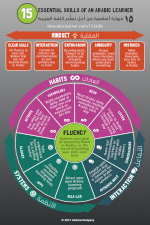Set a clear goal of becoming fluent in Arabic
What are your goals?
This article is based on the 15 Essential Skills of an Arabic Learner.
What is your goal in wanting to learn Arabic? As you begin your journey, where do you picture yourself when you finish? If you are already on that journey – at any level – where do you see yourself finishing? Have you ever thought about what finishing would look like?
Setting a clear goal in your mind that you CAN and WILL become fluent in Arabic. This is one of the most important foundational beliefs that you need as you approach learning the language.
By setting the goal of being fluent, all of your activities that follow will have purpose and focus. And yet it is amazing to me how many people approach learning Arabic without having a clear vision of themselves becoming fluent.
As I write this, I can easily bring to mind conversations with many people who, after several years in Egypt , and would say to me some variation of “There’s no way I can really learn Arabic well, but I should at least try to get some basics”.
On one hand, I totally support the need to realistically assess how much we can get done with the time we have. But at the same time, there are two fundamental problems with this mindset. The first is a lack of belief that Arabic is actually learnable. And the second is that this person does not have a clear picture of what they want to learn. Let’s take a minute and look at each of these, starting with the second.
No goal of fluency = no fluency
It is generally understood, in education and business, that clear goals lead to higher achievement. If you want to accomplish something, set a goal and pursue it. If you need to learn something, know what that thing is and then pursue it. No one accidentally stumbles into high achievement.
But somehow the process of language learning often seems to elude having goals. The vast majority of people who want to learn any language don’t have a clear idea of where they want to finish. Perhaps this is because learning our first language is something we do innately, as a child. The process takes place without us having to set goals and work toward them, and the outcome is that we become fluent speakers of our first language. So when we approach learning a second language as teens or adults, we don’t necessarily have a clear framework in our mind of what we need to do to become fluent, or how to approach the task.
In the case of Arabic, many learners approach it in order to “tinker”. According to Dr. David Wilmsen, Chair of the Department of Arabic and Near Eastern Languages at the American University of Beirut, they come at it with the goal of learning “just enough” Arabic to do whatever it is that they need to do, and then fall back on English (or whatever other language is most spoken in their setting)[1].
The problem with this is that having no clear goal of fluency means no fluency will be achieved. By setting a goal of actually becoming fluent, you will activate all of your thinking, motivation, and energy to launch you and sustain you on your journey to becoming competent in Arabic.
How to set and update goals
Why settle for tinkering? As an Arabic learner, I have found it helpful to take a few moments to mentally picture myself in specific situations where I am fluently interacting in Arabic. I picture myself in the middle of conversations at work, or in a leisure activity. I imagine myself in a group of people speaking about a topic I am passionate about, with them listening and asking questions.
In my first year I came to Egypt, my room-mate had a 3-year plan for learning Arabic, and each of the three years had a clear, achievable milestone of how he would be able to communicate in Arabic. This really helped him achieve a strong level of communication in Arabic, and it provided me with a good model for setting goals. I learned quickly that my goals were too small and needed to be upgraded (as I wrote about in this post).
Abbas Al-Tonsi is a co-author of one of the most widely used Arabic language textbooks in the world, Al-Kitaab fii Tacallum al-cArabiyya (الكتاب في تعلم اللغة العربية). When I asked him to tell me about one student he taught that stood out in his mind as an outstanding Arabic learner, he immediately mentioned Kristen Brustad, also a co-author of the Al-Kitaab series, and currently Associate Professor in the Department of Middle Eastern Studies, the University of Texas at Austin. He said “…I didn’t expect by the end of the year that she would be able to read and write Arabic at this level”. One factor he saw that he felt contributed toward her success was a clear understanding of what she wanted to achieve, and continually pushing in that direction and asking for more resources to help her[2].
When I brought this up with Dr. Brustad, she laughed, and later in the interview went on to elaborate, “Another thing is they [successful Arabic learners] keep adjusting their goals upward and upward and upward. They keep seeing they can do more and they keep setting their goals higher and higher for themselves.”[3]
Believing that Arabic is learnable
Once you set clear goals, a second problem that you will face that is the limiting belief that Arabic is a difficult language and can never be fully mastered. This is usually an unspoken belief, but it is held by many Arabic learners and Arabic teachers alike, according to Dr. Kirk Belnap, Director of the National Middle East Language Resource Center at Brigham Young University.[4]
While this problem can be found with numerous languages, there are a number of sociolinguistic, historical, and religious factors that have made it especially noticeable when it comes to Arabic. For the majority of Arabic speakers, the unique model of perfect Arabic is the Qur’an, the holy book of Islam. The classical Arabic of the Qur’an differs significantly from the spoken dialects that are found in each region across the Arab world. Having a model of Arabic that is seen as perfect but is not used fluently by most native speakers of Arabic in the world, contributes to the perception that Arabic is an unattainable language. According to Kristen Brustad, who is writing an article on this subject for a book that will soon be published, this problem is not new. It can be seen historically as early as 800 AD, when Arabic was being learned by many speakers of other languages in the newly formed Islamic empire[5].
Add to this the fact that Arabic, as a Semitic language, does not resemble the first languages of most Arabic learners. Most Western or East Asian languages have few connections to Arabic. Even in languages that have a high level of borrowed words from Arabic (such as other languages of the Middle East, south Asia, or parts of Africa), there is still a high level of variation.
The end result of all of this is the widespread idea that Arabic can only really be learned by native Arabic speakers, and that even then it is extremely difficult to master. This belief is held by Arabic learners and teachers alike.
As an Arabic learner, you need to recognize this as a limiting belief that will prevent you from reaching your goal of fluency. You must believe that Arabic is learnable, if you want to make significant progress toward becoming fluent. And if you are learning from a teacher or tutor, you need to find one who actually believes that you can learn Arabic and become fluent in it.
Once you believe that you CAN learn Arabic, and set fluency as your clear goal, you will have a more effective mindset to make significant progress as an Arabic learner.
Action steps for you to take
- Write answers to the following questions in a document or on a paper that you can refer to later.
- What is your goal in wanting to learn Arabic?
- What will it look like when you finish? List what you will be able to do in Arabic.
- Do you believe that Arabic is a language that you can actually become fluent in? Why or why not?
[1] Personal interview with David Wilmsen, April 28, 2015
[2] Personal interview with Abbas Al-Tonsi, May 1, 2015.
[3] Personal interview with Kristen Brustad, May 18, 2015.
[4] Personal interview with Kirk Belnap, June 4, 2015
[5] Personal correspondence with Kristen Brustad, January 10, 2015



 RSS - Posts
RSS - Posts
That was a v interesting and helpful post. Thank you. I hadn’t really thought about fluency in speaking the language as I don’t really have a great desire to speak. I think in terms of reading rather than speaking. (Now that you have made me think about this, I believe my penchant for reading comes from having spent much of my childhood in bed with books, recovering from bouts of malaria.)
But, certainly, fluency comes into what I want. I have two goals: 1) to read Egyptian newspaper stories so rapidly that I can translate them and type them out in English as I read and, eventually, (2) to read ‘Kalila wa Dimna,’ which, I suppose, will be almost like having to learn another language.
I shall certainly take your advice and set fluency in speaking and writing, as well as reading, as my goal
Thanks Ramez. I think that when it comes to reading, the principle is the same as for speaking. You activate and accelerate what are learning by actually using it for real interaction. Interaction here meaning exchange of meaning. I like your fluency goals for Arabic!
I was recently listening to a podcast about language learning and one of the suggestions for activating the ability to read fluently surprised me. It was watching English language movies that have Arabic subtitles, and trying to follow/understand the subtitles. I have always tended to think about watching Arabic movies with English subtitles to help you when you need it, but apparently the effort of trying to read the subtitles in Arabic at a speed that goes with the flow of the movie provides the stretching that helps, with English audio in case you fall behind or can’t understand something.
I watch the TV news in Arabic, but find it difficult to make out what the news readers say. So I try to read the captions that appear at the bottom of the screen. I think I’m getting better at that.
My funniest experience with trying to imbibe a bit of Arabic was,perhaps, watching an Arabic film in a cinema here many years ago with a restive audience whose understanding of the Arabic used–the Algerian version–was no better than mine. There was a sigh of relief when a French officer in the film shouted with a loud hailer at an approaching crowd, “Que voulez vous?” Everybody understood that. I heard later that Arabic subtitles were added for further screening of the film.